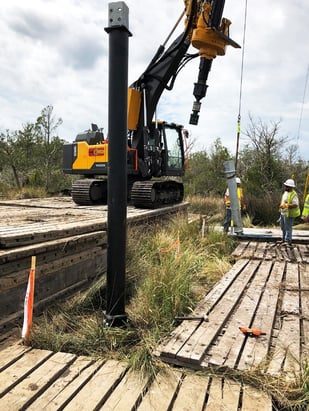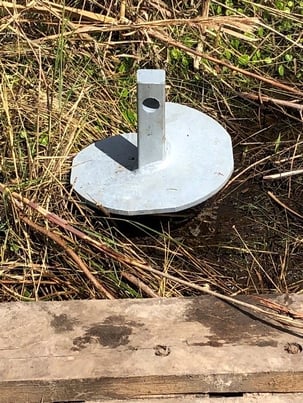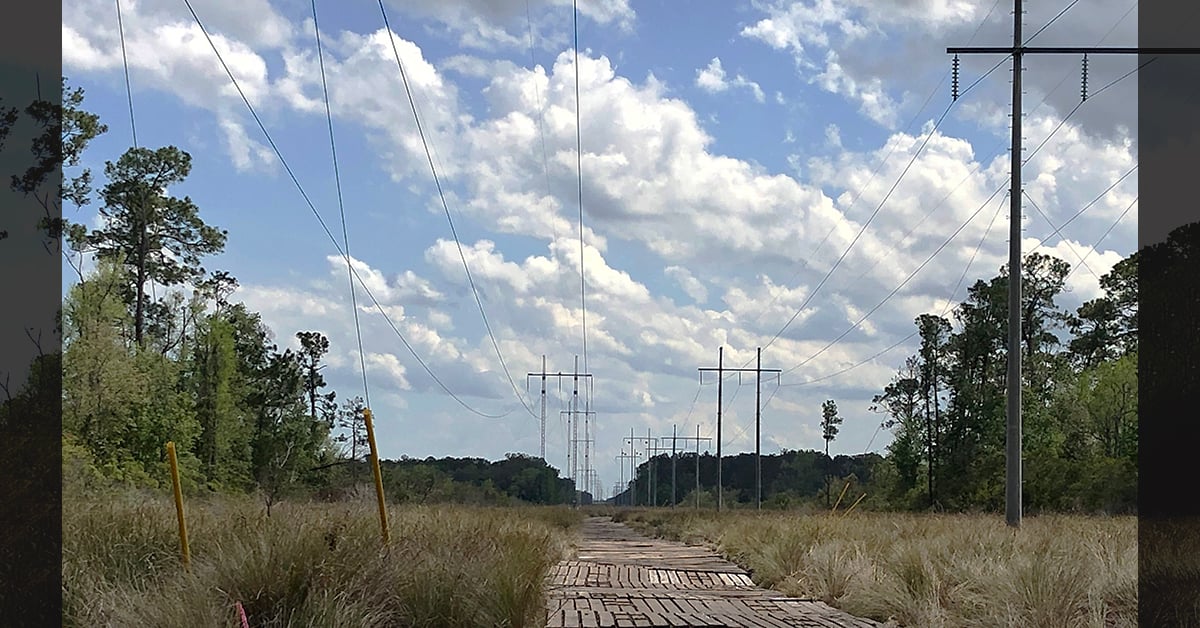This post was originally published on January 3, 2020 and updated on June 21, 2022.
Electric Utility Engineers who design and maintain transmission lines face many challenges including weak, soft soils that can’t bear much weight and aggressive soil that corrodes metal. Whether you are facing Virginia’s Coastal Plain or western Colorado’s Mancos Shale, CHANCE® offers protection to ensure the foundations and anchors that support transmission towers will function properly and withstand the test of time.
Transmission Towers in Soft Soils and Corrosive Environments
Hubbell engineers were called to find a solution when an inspection of a 230kV transmission line south of Brunswick, GA (on the Atlantic coast) uncovered some of the original foundations were missing at the footings of the structures. The sensitive wetland location called for minimal matting, limiting vehicle size and weight. Existing guy wires to the structures constrained overhead work clearance. The importance if this line required the restoration to be done while the line remained energized. And, of course, the new foundations need to withstand the very corrosive environment, so they wouldn't be faced with another replacement in the near future.
In this situation, the known corrosiveness of the soil called for engineers to customize the anchors for additional protection and longevity. For additional reading on how long you can expect your helical piles or anchors to last, you can read Service Life Expectation for CHANCE® Guy Anchors and Helical Piles.
A report on water main breakage includes this map created with data collected by the U.S. Department of Agriculture showing the steel corrosion potential in the United States. It's clear that steel corrosion is not just a coastal issue and that it's important for engineers throughout the country to consider the soil boring data carefully in their designs.
The Engineers' Solution
When the Hubbell Power Systems engineering team was provided with the information for this project, they went to work designing a helical foundation system that, along with supporting the structures, would also address the challenges of installation and longevity. The structure information gave the team the necessary details to select the proper foundation size. Borings from the site let them know the depth of the marsh and soil composition below to reach a suitable bearing surface for the ne w foundations. And to resist the corrosion of the briny tidal flow, the steel helical foundation sections were sized thicker and were treated with a special, heavy-duty galvanizing combined with an overcoat of tar epoxy.
w foundations. And to resist the corrosion of the briny tidal flow, the steel helical foundation sections were sized thicker and were treated with a special, heavy-duty galvanizing combined with an overcoat of tar epoxy.
Installing the New Foundations
On the day of installation, a lightweight, low-profile drilling rig maneuvered into position and easily drove the foundation sections into the marsh. Helical piles can be installed with small, lightweight equipment to reduce right-of-way impact. No soils need to be removed in environmentally sensitive areas and they eliminate possible damage caused by concrete trucks travelling to the jobsite.
A CHANCE® wireless torque indicator monitored the progress of the helical pile lead and extensions. The indicator measures torque using strain gauges attached to the center shaft. Torque values are displayed on the indicator and are transmitted via Bluetooth™ to smart devices. There is a direct correlatio n between installation torque and foundation capacity, which can be calculated by engineers based on the job site soil profile. Read more about torque correlation and capacity. Hubbell offers HeliCAP®, a free software that calculates helical anchor and pile capacity.
n between installation torque and foundation capacity, which can be calculated by engineers based on the job site soil profile. Read more about torque correlation and capacity. Hubbell offers HeliCAP®, a free software that calculates helical anchor and pile capacity.
When the pre-determined torque value was achieved, the helical pile installation was complete. They were now ready to be trimmed and capped to grade level, allowing for final placement of the structures.
The helical foundations were designed in manageable section lengths (8ft in this case), with similar-length extensions being added to reach the stable soil below the bed of the marsh. The smaller-sized equipment needed for this type of installation was able to stay well below safety clearances of the energized lines.

Additionally, as helical foundations do not disrupt the soil around them, the new foundations were able to be installed adjacent to the existing ones. Once the new foundations were installed and capped, the structure was hopped over from the old foundation to the new without ever disrupting power service.
The steel helical pile foundations overcame all of this project’s difficult constraints to provide these transmission structures with a sound foundation for decades to come. If you are facing a foundation challenge, contact your Hubbell Territory Manager and let our team help with a custom solution.

